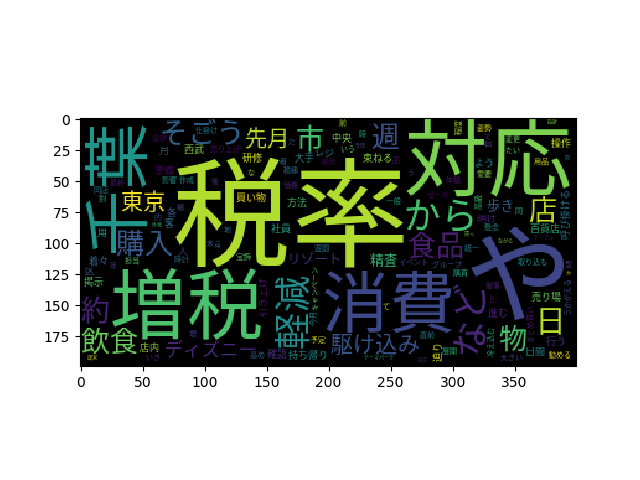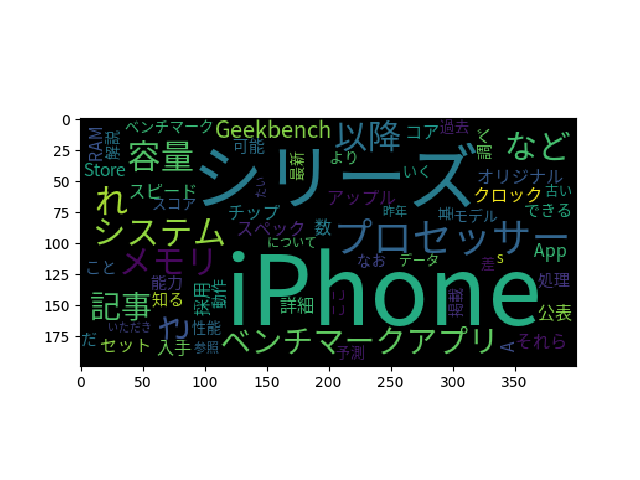目的
日本語のワードクラウドを使って新型iPhoneのニュース記事を可視化した際の備忘録です
準備
wordcloudをインストールします。
$ pip install wordcloud
フォントを下記サイトからダウンロードします
https://www.google.com/get/noto/help/install/
macOS
Download the font package (.zip)
Double click on the package to uncompress it
Open Font Book (Go to Finder → Applications → Font Book)
Select all of the font files and drag them to the Font column (i.e., the second column) of Font Book
コード
ネットから消費税が10%増税する関連のニュースをコピーします。
sample.py
# $ pip install wordcloud
# https://www.google.com/get/noto/help/install/
import matplotlib.pyplot as plt
from wordcloud import WordCloud
from MeCab import Tagger
t = Tagger()
text = """
消費税率の10%...(以下省略)
"""
splitted = " ".join([x.split("\t")[0] for x in t.parse(text).splitlines()[:-1]])
stop_words = ['する', 'せる', 'られる', 'あの', 'する', 'ある', 'とこ', 'なる', 'ない', 'ああ', 'れる', 'さん', 'やる', 'この', 'どう', 'そう', 'は', 'の', 'を', 'に', 'が', 'で','と','た','へ','し','も','や', 'て', 'か','いる', 'な' , 'ば', 'い', 'なかっ', 'いけ', 'でき', 'あっ', 'こと', 'ため', 'ます', 'これ', 'それ', 'その', 'さ', 'という', 'だけ', 'あろう', 'また', 'もの', 'よう', 'から', 'る', 'あろう', 'だ', 'れ', 'だから', "そして", 'あろう', 'あれ', 'あろ', 'う', 'oo', 'いい', 'ご', 'たい', 'なく', 'ぞ', 'とき', 'そこ', 'しかし', 'として', 'ooo', 'ぬ', 'ず', 'なっ', 'ZO', 'Zoo', 'O', 'なら', 'あ', 'こ' ]
wc = WordCloud(font_path="~/Desktop/python/wordcloud-jp/.fonts/NotoSansCJKjp-Regular.otf", regexp="[\w']+", stopwords=set(stop_words))
wc.generate(splitted)
plt.imshow(wc)
plt.show()
増税するらしき事が可視化によって明確になりました。
加えて、税率、消費、対応などが記事の焦点となっている事がわかります。
プロセッサー、容量、ベンチマークなど、新型は性能が注目されている事がわかります。
追記
ファイル(text.txt)から読み込む場合は下記
# $ pip install wordcloud
# https://www.google.com/get/noto/help/install/
import matplotlib.pyplot as plt
from wordcloud import WordCloud
from MeCab import Tagger
t = Tagger()
f = open('./text.txt')
text = f.read() # ファイル終端まで全て読んだデータを返す
f.close()
#text = ""
splitted = " ".join([x.split("\t")[0] for x in t.parse(text).splitlines()[:-1]])
stop_words = ['する', 'せる', 'られる', 'あの', 'する', 'ある', 'とこ', 'なる', 'ない', 'ああ', 'れる', 'さん', 'やる', 'この', 'どう', 'そう', 'は', 'の', 'を', 'に', 'が', 'で','と','た','へ','し','も','や', 'て', 'か','いる', 'な' , 'ば', 'い', 'なかっ', 'いけ', 'でき', 'あっ', 'こと', 'ため', 'ます' ]
wc = WordCloud(font_path="/Users/seigo/Desktop/python/wordcloud-jp/.fonts/NotoSansCJKjp-Regular.otf", regexp="[\w']+", stopwords=set(stop_words))
wc.generate(splitted)
plt.imshow(wc)
plt.show()
参考
【備忘録】日本語のワードクラウドを作る
Google Noto Fonts
PythonのWordCloudで遊んでみた【題材 : 吾輩は猫である】

